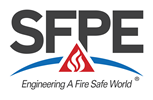Abstract
Current model building codes contain requirements for (1) the minimum number of exits and (2) the minimum egress capacity from a space, both based upon the occupant load served These requirements largely remain consistent for all spaces in a building, regardless of the height or number of stories There is some research that indicates an inefficiency during occupant traversal of exit stairwell landings, specifically during a merging event of flows of occupants from the floor and the stair above Both within exit stair enclosures and at the door leading to the exit stair, this inefficiency can lead to queues that form more quickly than the predicted by the hydraulic model egress correlations given in the SFPE Handbook This study uses an egress model to predict the time for occupants to clear a story and enter an exit stair across buildings of various heights It was found that the mean and maximum times for occupants to clear a given floor and enter an exit stair is directly proportional to the number of stories in the building.
Presentation
Resources
| Paper | Presentation | ||
|---|---|---|---|
| HTML | HTML | ||
| Resources Archive File (.zip) | |||


